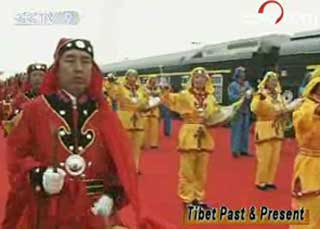------Program code: DO-080504-00236 (what's this?)
Source: CCTV.com
05-04-2008 07:19
Connecting with the World
Tibet; once far off the beaten path.
 |
| Watch Video: Part 1 |
Frescos are an important record of history in Tibet. Tangdong Gyibo, who lived from 1361 to 1455, appears on many of them because he built more than a hundred iron cable bridges across rivers in all parts of Tibet. He also created Tibetan Opera, in which the performers wear blue masks, as a means of raising money for the bridge construction. So Tibetan Opera has its origins in the desire of the Tibetan people to surmount the natural barriers and communicate with one another.
The ancient Tea and Horse Trail, which stretches from the tea-growing regions of Yunnan through Sichuan, across the vast Tibetan hinterland, and westward to Nepal and India, was built more than 800 years ago. Merchants traveled the road back and forth, carrying tea, salt, cloth and other commodities into Tibet, and taking medicinal herbs and animal pelts back with them. At that time, it took six months to a year to make the return journey from Ya’an in Sichuan to Lhasa. At the time Tibet was a closed country with primitive transport conditions, and the only way to cross the rivers was by cow-hide boat or the occasional suspension bridge.
Things begin to change
In 1951, the central government and the Tibetan local government signed the Agreement on Measures for the Peaceful Liberation of Tibet. This was an epoch-making event. From then on, everything in Tibet began to change, and it was at this time that the first modern road was built in Tibet.
The Sichuan-Tibet Highway
It is only 2,000 miles from Sichuan to Lhasa, but the terrain that has to be crossed, including fourteen mountains and a dozen rivers, is called a museum of the world’s geological disasters. An army of 100,000 road builders using the most primitive equipment cut a road across the roof of the world to the hinterland of Tibet. Nearly 10,000 Tibetan workers from 48 tribes worked on the biggest infrastructure project Tibet had ever seen. Han Chinese and Tibetans, soldiers and civilians, worked shoulder to shoulder, and the road from China’s interior to Lhasa was finally opened to traffic in late 1954. Thus was ended the isolation Tibet had endured since the beginning of time.
 |
The Qinghai-Tibet Highway
The highway from Qinghai to Lhasa was built at the same time as the Sichuan-Tibet Highway. The two of them together brought Tibet much closer to the rest of China. The state government provided material assistance for Tibet’s development and provided a constant flow of necessities to the Tibetan people living on the frigid high plateau. This assistance was of vital importance for eliminating Tibet’s isolation and backwardness, promoting a historic leap forward by Tibet’s social system, and liberating and developing the productive forces.
Changes in the lives of the people of Tibet: 1) Lhasa—butter tea
A highway to Lhasa
Tibetans cannot live without salt and tea. In the past when transport was so difficult, prices were exorbitant and people couldn’t afford to drink butter tea every day. But as soon as trucks started transporting huge cargoes of tea and salt to Tibet, the cost of these staples dropped quickly, and butter tea was no longer a luxury item.
When the highway reached Lhasa, it not only changed people’s lives, but also stimulated the development of the urban management, electric power, banking and postal systems. The people were surprised to see Lhasa turn into a modern city almost overnight.
The road network spreads out from Lhasa to the rest of Tibet
Beginning in 1989, the state government invested a total of 1.7 billion yuan in upgrading the Qinghai-Tibet Highway. The pace of road construction in Tibet picked up between 1995 and 2003, and major improvements were completed on five state highways: the Sichuan-Tibet Highway, Qinghai-Tibet Highway, China-Nepal Highway, Xinjiang-Tibet Highway and Yunnan-Tibet Highway. In addition, provincial roads connected Tibet to Sichuan and Yunnan in the east, Xinjiang in the northwest, Qinghai in the northeast, and India and Nepal in the south. Meanwhile, roads within Tibet connected cities with each other and towns with the nearest city. The technical level and drivability of the roads constantly improved.
As a result of the central government’s investment in road improvements, the Sichuan-Tibet Highway and Qinghai-Tibet Highway, which carry 90% of the freight traffic into and out of Tibet, are open year round, and three quarters of the 4,000 kilometers of the two roads are paved with asphalt. Even Ngari, the most remote of Tibetan cities, is connected by road to the rest of the region.
These roads are like tow-ropes that draw people out of their traditional subsistence lifestyle and bring them into the modern economy.
Changes are occurring at such a dizzying pace, that many Tibetans are finding it difficult to cope with them. Still, improvements in transport make it possible for them to take the bus to far-flung places, making it much easier to visit friends and relatives. New modes of transport are shrinking distances.
Map showing roads extending to all pastoral areas
Changes in the lives of the people of Tibet: 2) Production methods in pastoral areas
Before 1954, not only did Tibet have no roads; few people had ever even seen a car. Most people were frightened when they first set eyes on one. Those days are long past. Highways are now playing an essential role in ensuring a sufficient supply of the necessities of life. Highways are Tibet’s lifelines, and roads and motor vehicles play an indispensable role in the life and work of the people of Tibet. A driving license is a ticket to steady work and prosperity for the Tibetan herders.
Before roads were built in Tibet, merchants hauled their merchandise over long distances on the backs of goats and yaks. This practice was discontinued with the rise of modern business. When roads were built, the herders used them to transport animal pelts and table salt to places like Lhasa and Golmud, where they sold them at wholesale markets and bought household articles to take back to be sold in local stores. Chain stores opened up, and consumer goods began to be distributed in rural communities.
